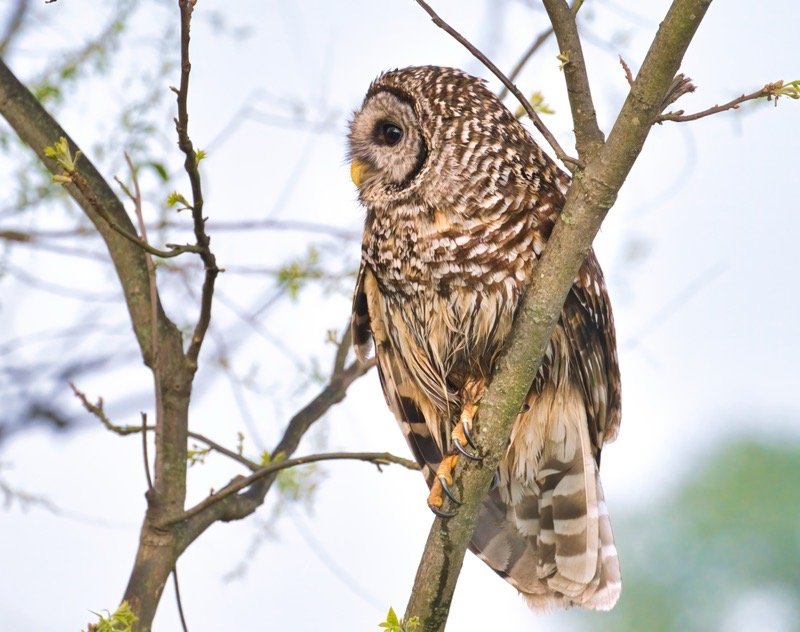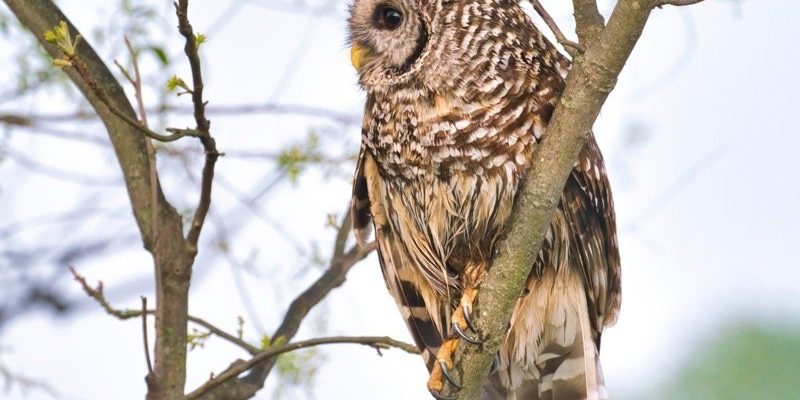
Imagine yourself in a dense, moonlit forest. The air is cool, and suddenly, you hear a soft, rhythmic “who cooks for you? Who cooks for you all?” echoing through the trees. This call belongs to the Barred Owl, and it’s not just for show. It’s a crucial part of how these birds communicate and establish their territory. Their hunting prowess, combined with their excellent flying abilities, lets them thrive in various environments. Come along as we explore how these birds navigate the night sky and capture their meals, from technical flying tricks to clever hunting strategies.
Understanding the Barred Owl’s Physical Attributes
Before diving into their hunting and flying techniques, it’s essential to understand what makes the Barred Owl unique. These stunning birds thrive in wooded environments across North America, showcasing a combination of physical features that contribute to their success as hunters.
Barred Owls have a stocky build, with a rounded head and large, expressive eyes that are perfect for night vision. These eyes are not just for show; they provide excellent depth perception and help them spot prey from great distances. The owl’s feathers are brown and white, giving it great camouflage in its natural habitat, helping it blend in with tree bark and leaves.
Also, their wingspan is quite impressive—up to 50 inches! This allows for silent, graceful flight. The special design of their feathers reduces noise, which is crucial for stealthy hunting. Think of it like wearing soft-soled shoes, making it easier to sneak up on unsuspecting animals below.
How Barred Owls Fly Like Masters of the Night
When it comes to flying, Barred Owls have some pretty nifty techniques. Their flight style can be described as low and slow, almost like floating. This is a tactic to maximize stealth, especially when hunting. Instead of swooping down like some hawks, Barred Owls prefer to glide through the trees, using their wings to catch air currents.
Their wing flapping is deliberate and calculated, allowing them to cover long distances without much effort. You might be wondering how they manage to control their flight so well. It’s all in the design of their wings! Barred Owls have broad wings that create a lot of lift, which is perfect for gliding silently through their environment.
Additionally, they often fly just above the treetops, which makes it easier for them to spot movements below. This combination of stealthy gliding and strategic flying locations allows them to survey and hunt in their territory effectively.
Hunting Techniques That Set Barred Owls Apart
When it comes to hunting, Barred Owls employ a mix of patience and precision. They typically hunt at night, relying on their incredible hearing and vision. If you’ve ever been in a quiet forest at night, you know how sounds travel. Barred Owls can hear even the faintest rustle of leaves or crack of a twig, which helps them locate prey hidden beneath the foliage.
They have a keen ability to *detect sounds* from various directions, thanks to the positioning of their ears. One ear is slightly higher than the other, which helps them pinpoint exactly where a sound is coming from. Imagine using a pair of headphones to hear your favorite song; that’s how precise they are when tracking their next meal.
Once they spot their target—often small mammals like mice or rabbits—they don’t rush in. Instead, they sit quietly, waiting for the perfect moment to pounce. When they finally launch into action, they can dive down at remarkable speeds. Their powerful talons are equipped to catch and hold onto their prey firmly, ensuring a successful hunt.
The Role of Camouflage in Their Hunting Strategy
One of the more interesting aspects of the Barred Owl’s hunting technique is *camouflage*. Thanks to their unique plumage, they can blend into their environment effortlessly. This is particularly important for a nocturnal hunter because it allows them to remain hidden from both prey and potential threats.
Their bark-like feathers mimic the textures and colors of tree trunks, making it challenging for animals to spot them. Picture a good camouflage outfit in the military—it serves a similar purpose. When perched on a branch, a Barred Owl doesn’t just sit there; it becomes part of the scenery.
This blending ability isn’t only helpful for hunting; it’s also a defense mechanism. By staying hidden, they can avoid confrontation with larger predators. This stealthy behavior is a fine balance between hunting efficiently and ensuring their own survival in the wild.
Barred Owl Communication: More than Just Hooting
Communication plays an essential role in the life of a Barred Owl, especially when it comes to hunting and mating. Their famous calls, which sound almost melodic, aren’t just for show. These calls serve multiple purposes, including establishing territory and attracting mates.
Interestingly, a Barred Owl’s hoots can convey different messages, depending on the rhythm and pitch. This vocal communication is crucial when hunting, as it can help coordinate with a mate or alert them to potential threats. Imagine being in a crowded room and calling out to a friend; the way you say their name can change how they respond.
Young Barred Owls, or owlets, also communicate with their parents through high-pitched squeaks, especially when they’re hungry. This sound lets the parents know it’s time to bring home dinner. It’s a fascinating aspect of their behavior that ties back to their hunting success and family dynamics in the wild.
The Impact of Environment on Barred Owl Hunting
The environment plays a significant role in shaping the Barred Owl’s hunting techniques. They typically inhabit forests, swamps, and wooded areas, providing plenty of cover and hunting opportunities. This habitat choice is no accident; it allows them to thrive.
In dense forests, they find many hiding spots and ample food sources. However, changes in the environment, such as deforestation and urban development, can impact their hunting success. Without enough trees, their camouflage is compromised, and their prey becomes more challenging to find.
Additionally, seasonal changes can affect available food sources. During winter, when snow covers the ground, these owls may need to adapt their hunting strategies. You might see them hunting in more open areas or adjusting their calls to locate prey in new locations. Their ability to adapt is a testament to their survival skills and intelligence in the wild.
Preserving the Future of Barred Owls
As fascinating as the Barred Owl’s flying and hunting techniques are, their future is not guaranteed. Environmental changes and habitat loss threaten their populations. Conservation efforts are critical in ensuring these magnificent birds continue to thrive in the wild.
By protecting their habitats and supporting local wildlife organizations, we can help secure a future for Barred Owls. This includes maintaining forests, wetlands, and natural areas that provide essential resources for these birds.
If you ever find yourself in an area where Barred Owls reside, remember that your actions matter. Keeping the environment safe and pristine not only benefits these remarkable creatures but also preserves the magic of nature for future generations.
As we wrap up our exploration of the Barred Owl, it’s clear these birds are more than just nighttime companions in the woods. With their unique flying and hunting techniques, coupled with their remarkable adaptability, they showcase the beauty and complexity of nature. Understanding their behaviors and challenges can inspire a deeper appreciation for wildlife and the importance of conservation. Next time you’re out at night, listen for the haunting call of the Barred Owl. You might just feel a little wiser for it!

